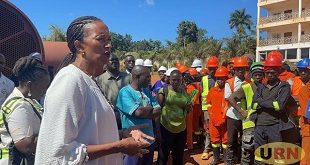
Oyam, Uganda | THE INDEPENDENT | In April 2019, seven-month-pregnant Dorcus Aceng met her death when she unknowingly came into contact with an agitated elephant that had strayed from Murchison National Park.
That fateful day, Aceng was at home going about her normal business when the elephant came running across her compound located in Onea ‘A’ village, Juma parish in Oyam district. The wild animal having been chased by villagers from a maize plantation pounced on Aceng, tearing her chest and belly. She died on the spot.
That same elephant later killed a catechist in the next village bordering the park. This is one of the many cases of wild animals not only injuring but also killing locals especially those living along the park line. Moses Kego, Aceng’s husband says he had briefly stepped out of home for leisure when his friends came to inform him that his wife is dead.
He described the incident as “unforgettable and unforgiving,” because Uganda Wildlife Authority (UWA) only contributed Shs.1.5m for burial despite the financial losses his family incurred and the psychological trauma he is dealing with up to date.
“LCII, LCIII tried so much to ensure that people from the park (UWA) for compensation or even supporting the burial expense but we received only 1.5 million shillings from UWA towards the burial yet we sold land at 3 million shillings to facilitate the burial. Ever since then we have not received any other kind of help from UWA but we are still suffering.”
As human populations increase while natural habitats decline, people and wild animals are increasingly being forced to compete for space often pitting conservation objectives against the livelihoods and safety of local communities.
Human-wildlife conflict occurs both inside and outside the park for various reasons including behavioral traits of the animal species, and communities illegally entering the park to access wildlife resources like bush meat, but the most common is wild animal’s attraction to cultivated crops that are known to be richer in macronutrients and mineral salts than wild plants.
For example, young elephants need a lot of energy-rich foods like sugarcane which support their growth up to the age of around 30 while protein-rich foods like leguminous plants (mostly grown by farmers) are also important for muscle growth.
Emmanuel Okello Ugen, a Uganda Wildlife Authority (UWA) Community Conservation Ranger attached to Murchison Falls National Park says elephants have always been identified as the common destroyer of crops due to their body mass, saying sometimes they are killed in retaliation.
This has led to major losses for farmers, worsening food insecurity, loss of human lives and also killing of wild animals as well as endangering the animal species.
Local communities came up with several traditional methods to reduce and prevent human-wildlife conflict situations including crop-guarding, chasing elephants by making noise (shouting, drum-beating, fire-crackers), and digging of pits to act as physical barriers for the animals. All these have not yielded much fruit.
Over the years, UWA has also intensified measures for wildlife conservation including erecting electric fences for physical exclusion and incorporating community wildlife scouts, many of whom are reformed poachers to help rangers. Okello Ugen said the scouts are tasked with reducing Human-wildlife conflict and reporting cases of wildlife attacks on the communities, among other responsibilities.
In Nwoya district, the scouts have devised a local remedy; organic repellent (a mixture of cow dung, onions, garlic, neem leaves, cooking oils, raw eggs, and other locally available ingredients) which when sprayed on the crops can keep the wild animals away from their farmlands. The residue can also be molded in cake-like shapes burnt near the gardens for the same purpose.
Bosco Opira, the head scout in Got-Apwoyo sub county Nwoya district says the organic repellent is the most effective way of keeping wild animals especially elephants away from their gardens.
According to Opira, the repellent is also a very good pesticide for crops and fruit trees. “You see this jackfruit, some pests infested it and turned both its leaves and fruits yellow and it started drying but I applied the organic repellent and that’s how it survived.” He bragged.
Adding that; “both the oranges and mangoes you see now bearing fruits was doing so bad. The leaves had started withering and falling off but when I sprayed using the organic repellent, it improved and is now bearing fruits.”
“Even the pawpaw when sprayed with the repellent, not a single elephant will touch it.” He continued.
He is however, disappointed that some Non-Governmental Organizations invested in their products for the organizational gain at the expense of the scouts and local communities.
“World Aid had a different target and they supported us to produce the repellent twice; the first time we were told the repellent was for sale and they distributed it to different districts were it was sold and people bought because they needed it to help them. The second time is when we really suffered and if the scouts were recruited by this NGO, there wouldn’t be any scout in Nwoya. We produced ten water drums of repellent each measuring 10 liters which are completely sealed up to date, no one is using it. The NGO even left; abandoning us without anything and now the scouts are unable to produce any more organic repellent.”
Opira wants the government to invest in organic repellent. “The organic repellent being produced by the scouts in Got- Apwoyo should not be abandoned. Let them find a way of supporting the scouts to produce more because we have tested and proven that people need it and are willing to buy; people from Bweyale are calling me to find out if we are still making and I told them no because the other NGOs disorganized us completely.” Okello Ugen believes that this local remedy has been effective and efforts are underway to scale up its production.
However, David Otyeno, the chairperson community scouts in Juma parish Oyam district described an elephant as a very bright animal which puts off any fire near the garden and the organic repellent is only effected for a few days.
“Coming to 2028/2019 when it started killing people, the elephants had become so wise and violent because it was used to all our interventions. They never cared about our blowing vuvuzelas, and even the repellent residue when you burn it near the garden, the elephant would just come and put off the fire making it ineffective. The only way to manage them is to guard your garden.”
Otyeno wants UWA to consider continuously supporting scouts saying the physical chase of elephants is the only way of keeping them away.
“We are like soldiers who fought to defeat the rebels who should be given a project with support from UWA to help them because we have suffered a lot. There are scouts left with physical injuries like myself; I fell in a pit and developed a problem on my back and now I am unable to dig while others are now disabled and yet we are not sure this is the last time we shall be dealing with these elephants because at any time elephants may come just like last week when they came and we were expected to chase them back to the park. So it is important for us to be alert every time to chase them when they come and yet when the situation is calm like now, UWA forgets about scouts.”
In 2022, the Ugandan government announced the operationalization of the Wildlife Fund to commence compensation of victims of human-wildlife conflict. The compensation scheme provides for compensation claims for human death, injuries or damage to property caused by a wild animal outside a protected area, as provided under Section 83 of the Uganda Wildlife Act, 2019.
However, the affected communities say not a single person has been compensated although others confirm having received support towards the burial of their relatives killed by the wild animals. Nomi Otyeno, the councilor representing Kamdini sub county in Oyam District Council cited a few incidences where families who lost relatives are languishing in poverty.
Daniel Ogwara, is a resident of Bombay parish in Oyam district who is living with injuries inflicted on him by a stray elephant with little support from UWA.
“People discovered me from under the soil when my body was covered in wounds and I could not see properly because the elephant kept spitting on my face and my collar bone had dislocated and then I felt a lot of pain in my chest. People from the park (UWA) gave me shillings one hundred and fifty thousand for medical treatment up to date they have not added anything and yet I’m still in pain and cannot see properly. I am struggling to raise my children due to the pain.”
The Uganda Wildlife Act provides for revenue sharing where communities surrounding the park are given 2 percent of the total revenue collected. However, Nomi Otyeno is disappointed that most villages which are affected by the wild animals are not listed among beneficiaries of the scheme.
He wants compensation expedited. “They have talked about compensation but as to when the law will be effected, whether the law is already in place to have people compensated or not, nobody is aware and if is in place, when was the law effected?” he asked. Adding that “I would advise that let that law be amended to also have the human face.”
The East African country suffered massive declines in some species between the 1960s and 1980s as political conflict and lawlessness allowed poaching, trafficking, and encroachment on wildlife areas to thrive. Since then, the government has brought in a string of conservation policies, including lengthy jail terms for violations which has allowed the Wildlife populations to recover steadily.
A study by the Wildlife Conservation Society (WCS) states that Uganda today has over 7,000 elephants, mostly found in the Kidepo, Murchison-Semliki, and the Greater Virunga Landscape. With a very low reproduction rate of one calf per female every 8.6 years, elephant populations recover more slowly than many other animals, with a maximum annual population growth of about six percent.
****
URN
 The Independent Uganda: You get the Truth we Pay the Price
The Independent Uganda: You get the Truth we Pay the Price



